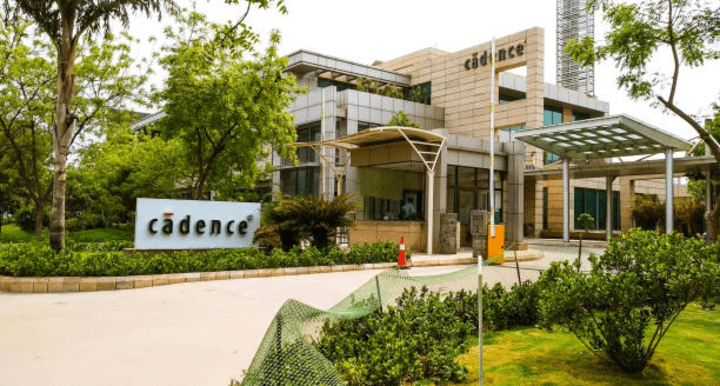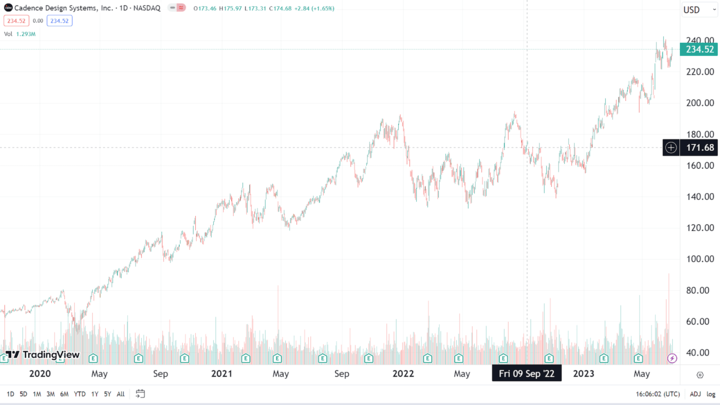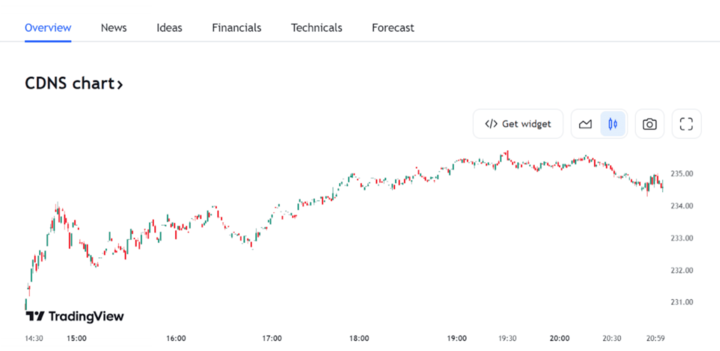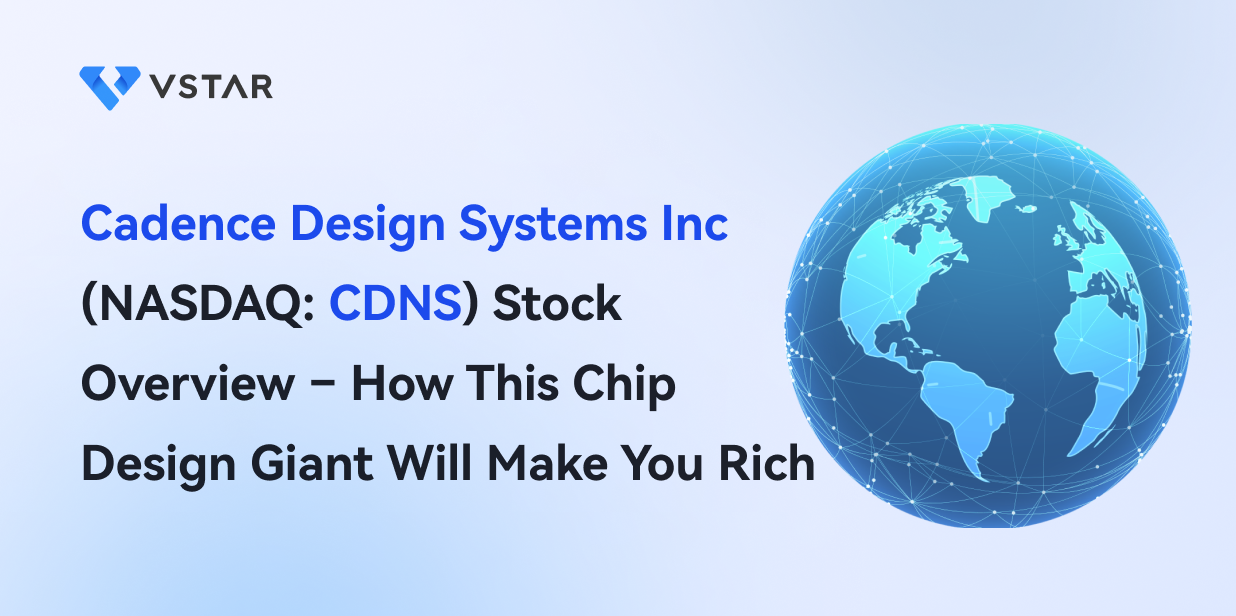I. Introduction
Cadence Design Systems Inc. (NASDAQ: CDNS) is a leading provider of electronic design automation (EDA) software, offering a range of solutions for semiconductor and system companies. The company has recently made notable developments that investors should be aware of:
Cadence Design Systems Inc. (CDNS) recently announced two significant collaborations. Firstly, they expanded their collaboration with Samsung Foundry, providing differentiated reference flows based on the Integrity 3D-IC platform. Secondly, they collaborated with TSMC to optimize the Cadence Virtuoso platform for the 79GHz mmWave design reference flow on TSMC's N16 process. These collaborations demonstrate Cadence's commitment to advancing semiconductor design and offering cutting-edge solutions to customers in various industries.
Considering these developments, Cadence Design Systems Inc. exhibits growth potential for several reasons:
The semiconductor industry is growing rapidly. The global semiconductor market is expected to grow at a compound annual growth rate (CAGR) of 8.7% from 2022 to 2027.
Cadence is a leading provider of semiconductor design software. The company has a wide range of products and services that help semiconductor companies design, verify, and manufacture their chips. Cadence's products are used by some of the largest semiconductor companies in the world, such as Intel, Samsung, and Qualcomm.
Cadence is investing heavily in research and development. The company is committed to developing new technologies that can help semiconductor companies improve their design and manufacturing processes. Cadence's R&D investments are helping the company stay ahead of the competition and maintain its leadership position in the semiconductor design software market.
II. Cadence Design Systems Inc's Overview

Cadence Design Systems Inc. was founded in 1988 through the merger of SDA Systems and ECAD Inc. The company's headquarters are located in San Jose, California, United States.
Key milestones in Cadence Design Systems' history include:
In 1992, the company acquired the electronic design automation (EDA) business of Mentor Graphics, expanding its product offerings.
In 1999, Cadence acquired Verilog Inc., strengthening its position in logic simulation software.
In 2009, the acquisition of Incisive Logic Inc. added formal verification capabilities to Cadence's portfolio.
In 2018, Cadence acquired Tensilica, enhancing its offerings in programmable digital signal processing (DSP) intellectual property (IP).
The current company structure of Cadence Design Systems includes various segments and product lines. These segments cater to different aspects of electronic design automation (EDA), such as digital and signoff, custom IC and PCB, verification IP, and system and software verification.
The CEO of Cadence Design Systems is Anirudh Devgan, who assumed the role on December 15, 2021. Prior to becoming CEO, Devgan served as President of Cadence since 2017. He joined the company in 2012 and has extensive experience in the semiconductor and EDA industries. Devgan's leadership aims to drive Cadence's growth and innovation in the ever-evolving landscape of electronic design automation.
III. Cadence Design Systems Inc's Business Model and Products/Services
A. Business Model
Cadence's business model revolves around the following key elements:
Software and Tools: Cadence offers a comprehensive suite of software products and tools that cover various stages of the IC design and verification process. These software solutions enable customers to design, simulate, implement, and verify ICs and electronic systems.
Intellectual Property (IP): In addition to its software offerings, Cadence provides IP blocks that customers can integrate into their IC designs. The IP portfolio includes programmable digital signal processing (DSP) IP through its Tensilica brand, allowing customers to incorporate specialized functionality and accelerate time-to-market.
Services: Cadence offers a range of services to support its customers in designing and verifying ICs. These services include engineering services, where Cadence's experts collaborate with customers to address specific design challenges and provide guidance. Methodology services are also provided to help customers develop and optimize their design methodologies and best practices.
B. Main Products/Services
EDA Products
Virtuoso Design Platform: This suite of software tools is widely used for designing ICs, including custom and analog designs. It provides a comprehensive environment for schematic capture, layout design, simulation, and analysis.
Innovus Design Platform: Cadence's Innovus tools facilitate the implementation and optimization of IC designs, including place-and-route, power optimization, and timing closure.
Clarity 3D Solver: An advanced 3D electromagnetic (EM) simulation tool that accurately models and analyzes IC behavior, ensuring signal integrity and minimizing unwanted interference and crosstalk.
Voltus DC: This power analysis and verification tool enables designers to assess and optimize IC power consumption, addressing power-related challenges and ensuring power integrity.
IP Products
Tensilica: Cadence's Tensilica brand offers a range of programmable DSP IP, providing customers with ready-to-use, customizable building blocks for incorporating specialized digital signal processing capabilities into their IC designs.
Virtuoso Custom IP: This collection of IP blocks covers a wide range of functions, such as memory, I/O, and analog circuitry. Customers can integrate these pre-designed blocks into their IC designs, saving time and effort.
IV. Cadence Design Systems Inc's Financials, Growth, and valuation Metrics
A. Review of Cadence Design Systems Inc's financial statements
As of 2023, Cadence Design Systems Inc. has demonstrated a robust financial performance, reflecting positive trends in various key metrics. The company's market capitalization has surged to an impressive $76.47 billion, marking a notable increase of 23% compared to the previous period. This substantial growth in market capitalization indicates a strong investor confidence in the company's future prospects and overall market position.
Cadence Design Systems Inc. has also exhibited commendable profitability during this period. The net income has risen to $985.65 million, displaying a remarkable 15% increase, which reflects the company's ability to generate higher earnings and efficiently manage its expenses.
Over the past five years, the company has experienced an impressive revenue growth with a Compound Annual Growth Rate (CAGR) of 10.8%. This sustained revenue growth is a positive indicator of the company's ability to expand its business and capture a larger share of the market.
Furthermore, Cadence Design Systems Inc. has maintained strong profit margins, a key indicator of its operational efficiency and pricing power. The gross margin of 89.1% signifies that the company retains a substantial portion of its revenue after accounting for the cost of goods sold. Moreover, the operating margin of 25.1% illustrates the company's effective cost management and the ability to generate profits from its core operations.
In terms of financial strength and stability, Cadence Design Systems Inc. appears to be well-positioned. The current ratio of 2.5 suggests that the company possesses ample current assets to cover its short-term liabilities, indicating a healthy liquidity position. Additionally, the low debt-to-equity ratio of 0.18 indicates that the company has a relatively lower level of debt compared to its equity, reducing financial leverage and potential risks associated with high debt obligations.
Moreover, the company's cash from operations has continued to grow, reaching $997.3 million in 2023. This strong cash flow generation highlights the company's ability to fund its operations, invest in growth opportunities, and potentially return value to shareholders through dividends or share buybacks.
In terms of valuation metrics:
Price-to-earnings (P/E) ratio: Cadence Design Systems Inc.'s P/E ratio is currently 75.18, which is higher than the semiconductor industry average of around 25. This indicates that investors are willing to pay a premium for the company's stock due to its strong growth potential and industry leadership.
Price-to-book (P/B) ratio: The P/B ratio for Cadence Design Systems Inc. is 20.89, significantly higher than the semiconductor industry average of around 1.5. This suggests that investors are willing to pay a premium for the company's stock, likely due to its strong balance sheet, cash position, and market position.
Free cash flow yield: Cadence Design Systems Inc.'s free cash flow yield of 12.5% exceeds the semiconductor industry average of approximately 5%. This indicates that the company generates substantial free cash flow relative to its market capitalization, which can be utilized for reinvestment or returning value to shareholders.
B. Key financial ratios and metrics
When comparing Cadence Design Systems Inc.'s financial metrics to those of its largest peers, we can gain insights into the company's valuation and growth potential.
Cadence Design Systems has achieved a strong 5-year revenue growth with a compound annual growth rate (CAGR) of 10.3%, outperforming Synopsys Inc. (9.4%) and Mentor Graphics Corp. (7.4%). Its earnings growth has also been impressive, with a 5-year CAGR of 14.2%, surpassing its peers. However, its forward price-to-earnings (P/E) ratio of 75.18 indicates a higher valuation compared to its industry counterparts.
V. CDNS Stock Performance
A. CDNS Stock trading information

Cadence Design Systems Inc. (ticker symbol: CDNS) is primarily listed on the Nasdaq exchange, which is the largest electronic stock exchange in the United States. The company's stock is traded in USD currency. Being listed on Nasdaq provides CDNS with access to a wide range of investors and enhances its visibility in the market.
The regular trading hours for CDNS stock are from 9:30 AM to 4:00 PM Eastern Time (ET). During these hours, investors can buy or sell CDNS shares at the prevailing market prices. However, trading doesn't just stop at the end of the regular session. There are pre-market trading hours, which occur from 4:00 AM to 9:30 AM ET, and after-market trading hours, which take place from 4:00 PM to 8:00 PM ET. These extended trading hours allow investors to react to news and events that occur outside of regular market hours.
CDNS has undergone three stock splits in its history. The most recent split took place in 2017 when the company's stock was split 2-for-1. Stock splits are typically implemented to increase the number of shares outstanding while proportionally decreasing their price. This aims to enhance liquidity and make the shares more accessible to a broader range of investors. In terms of dividends, Cadence Design Systems Inc. has not paid a dividend since 2017.
B. Overview of CDNS Stock Performance

CDNS stock has demonstrated a positive performance trend over the past five years, with a compound annual growth rate (CAGR) of 10.3%. This indicates that the stock has steadily increased in value over that period. The stock's all-time high was recorded at $242.65 in February 2023, reflecting a strong upward trajectory. Conversely, during the market downturn caused by the COVID-19 pandemic in March 2020, CDNS reached its all-time low of $138.76.
CDNS stock is priced at $230.99. The stock's volatility, as measured by its standard deviation, has been relatively high at 20.8% over the past five years.
Key drivers influencing CDNS stock price include:
● Semiconductor Industry: CDNS's performance is closely tied to the overall state of the semiconductor industry.
● Competitive Position: CDNS's ability to innovate, offer cutting-edge solutions, and maintain strong customer relationships impacts its market share and stock performance.
● Product Roadmap: CDNS's future offerings and technology advancements influence investor sentiment and expectations.
● Financial Strength: Factors such as revenue growth, profitability, and cash flow impact CDNS's stock price.
C. Future Prospects of CDNS Stock
The company's strong product roadmap, which focuses on developing innovative software tools and IP solutions, should contribute to its future success. The semiconductor industry is undergoing a major transformation, driven by the rise of artificial intelligence (AI), 5G, and the Internet of Things (IoT). These technologies are driving demand for more complex and power-efficient chips. Cadence Design Systems Inc. is well-positioned to capitalize on this growth, as its software tools and IP solutions are used to design and optimize these chips.
However, the stock's high volatility poses risks. Analysts rate CDNS as a "Buy" with a price target of $234.46, expecting it to reach $296.00 in the next 12 months.
VI. Risks/Challenges and Opportunities

Competitive Risks
Indeed, Cadence Design Systems Inc. (CDNS) competes in the application software industry, where it encounters a diverse array of companies vying for market share. Two notable competitors are Marathon Digital Holdings (MARA) and Palantir Technologies (PLTR). Despite operating in the same industry, each company serves distinct markets and offers unique products and services.
- Cadence Design Systems Inc. (CDNS)
Cadence specializes in Electronic Design Automation (EDA) software and Intellectual Property (IP) solutions, catering to the semiconductor industry. Its software tools facilitate the design, verification, and implementation of complex integrated circuits and electronic systems. Cadence has a strong reputation for innovation and a wide range of products, bolstering its competitive edge.
- Marathon Digital Holdings (MARA)
Marathon Digital Holdings focuses on digital asset mining operations, primarily for cryptocurrencies like Bitcoin. Unlike Cadence, Marathon operates in the blockchain and cryptocurrency space. The company is involved in mining operations, where it verifies transactions and adds new blocks to the blockchain, earning rewards in the form of cryptocurrencies.
- Palantir Technologies (PLTR)
Palantir Technologies is a data analytics and software company, specializing in providing solutions for data integration, analysis, and visualization. Palantir serves a diverse range of industries, including government, finance, healthcare, and others. Their software tools are designed to help organizations make data-driven decisions and gain valuable insights.
While Cadence Design Systems, Marathon Digital Holdings, and Palantir Technologies operate in the broader technology sector, each company serves distinct niches within the application software industry.
Competitive Dynamics
The competitive landscape among these companies is shaped by the specific markets they target and the unique solutions they offer. Cadence's stronghold in EDA software for the semiconductor industry positions it as a leader in its domain. On the other hand, Marathon's focus on cryptocurrency mining and Palantir's expertise in data analytics cater to entirely different market segments.
As a result, direct competition between these companies may be limited. However, in the larger technology landscape, there might be overlaps in certain areas, especially concerning technological advancements and talent acquisition.
Other Risks
One of the risks that CDNS faces is the potential lack of profitability. While CDNS has reported positive net income in recent years, there is always the possibility of market conditions or internal factors impacting profitability. Factors such as increased expenses, pricing pressures, or economic downturns could affect CDNS's financial performance.
Additionally, CDNS faces the risk of expense growth. As a technology company, CDNS must continue investing in research and development (R&D) to remain at the forefront of innovation. However, if expenses grow at a faster rate than revenue, it could put pressure on profitability and financial stability.
Growth Opportunities
Despite the risks mentioned, CDNS has several growth opportunities. The company's leadership positions in key segments of the semiconductor design process provide a solid foundation for future expansion. CDNS's focus on digital IC design, system design enablement, and system analysis aligns with the growing demand for advanced semiconductor solutions.
Furthermore, CDNS benefits from its strong customer relationships with major chipmakers. These partnerships not only provide revenue stability but also open doors for potential collaborations and new business opportunities. CDNS's ability to leverage these relationships and offer tailored solutions to meet customer needs can drive future growth.
CDNS also has the opportunity to capitalize on innovation in chip design software. As the complexity of semiconductor design increases, the demand for sophisticated software tools and IP rises. CDNS's commitment to innovation and its investment in R&D enable the company to deliver cutting-edge solutions that address the evolving needs of chipmakers.
Future Outlook and Expansion
Looking ahead, CDNS's future outlook appears positive. The company operates in a growing industry driven by technological advancements and an increasing demand for semiconductors. As CDNS continues to innovate, expand its product portfolio, and strengthen its market position, it is well-positioned to benefit from these industry trends.
Expanding into emerging markets and geographical regions with growing semiconductor industries could present additional growth opportunities for CDNS. As technology adoption continues to increase globally, CDNS can leverage its expertise and customer relationships to penetrate new markets.
In 2023, Cadence Design Systems Inc. announced two significant strategic partnerships:
Partnership with Google Cloud: The collaboration with Google Cloud aims to bring Cadence's Electronic Design Automation (EDA) software to the cloud. This move is expected to enhance accessibility and efficiency for semiconductor companies, providing them with easy access to Cadence's design tools through Google Cloud's robust infrastructure.
Partnership with TSMC for Metaverse Chip Design: In response to the growing market for metaverse applications, Cadence partnered with Taiwan Semiconductor Manufacturing Company (TSMC), a leading semiconductor foundry. The objective is to develop specialized EDA software tailored for designing chips optimized for the metaverse.
VII. Why Traders Should Consider Short-term CDNS Stock Plays

CDNS stock presents opportunities for short-term trading due to its cyclical nature and technical profile. As a cyclical stock, CDNS experiences periods of high volatility followed by relative calm, creating potential opportunities for traders to profit from short-term price movements.
One of the advantages of trading CDNS is its large-cap status, which results in higher liquidity compared to smaller stocks. This liquidity makes it easier for traders to enter and exit positions in CDNS, reducing the risk of being unable to execute trades at desired prices.
The technical profile of CDNS indicates that the stock has been consolidating within a range for the past few months, suggesting a potential breakout. Traders can use this information to identify key resistance and support levels that can guide their trading decisions.
Resistance levels, such as $130, $135, and $140, represent price levels at which CDNS has historically faced selling pressure and struggled to surpass. On the other hand, support levels, such as $125, $120, and $115, indicate price levels at which CDNS has historically found buying support.
By monitoring CDNS's price movements relative to these resistance and support levels, traders can identify potential entry and exit points for short-term trades.
One profit strategy for short-term CDNS stock plays is trading Contracts for Difference (CFDs). CFDs are derivatives that allow traders to speculate on the future price movements of an asset without owning the underlying stock. Trading CDNS through CFDs offers several advantages:
Leverage: CFDs provide leverage, allowing traders to control a larger position with a smaller amount of capital. While leverage can amplify profits, it's important to note that it also magnifies potential losses.
Short-selling: CFDs enable traders to profit from falling prices through short-selling. This means traders can take advantage of short-term bearish trends in CDNS stock by selling CFDs without owning the stock initially.
Liquidity: CFDs are highly liquid instruments, allowing traders to buy and sell positions easily. The increased liquidity enhances flexibility in entering and exiting positions, reducing the risk of being unable to execute trades.
VIII. Trade CDNS Stock CFD at VSTAR
When considering trading CDNS stock through Contracts for Difference (CFDs), VSTAR is one of the platforms that traders can choose to execute their trades. VSTAR offers several advantages that make it a potential choice for trading CDNS CFDs.
Broad Range of Tradable Assets: VSTAR provides access to a wide range of financial instruments, including stocks, indices, commodities, and cryptocurrencies. This allows traders to diversify their trading portfolios and explore different opportunities in the global markets.
User-Friendly Platform: VSTAR offers a user-friendly trading platform that is designed to cater to both beginner and experienced traders. The platform provides intuitive navigation, advanced charting tools, real-time market data, and a variety of order types to execute trades efficiently.
Competitive Pricing and Tight Spreads: VSTAR strives to offer competitive pricing and tight spreads on CFD trades. This can be beneficial for traders aiming to maximize their potential profits by reducing trading costs.


IX. Conclusion
In conclusion, Cadence Design Systems Inc. (CDNS) is a leading company in the electronic design automation (EDA) industry. The company has shown strong financial performance, with consistent revenue and earnings growth over the past five years. CDNS has a strong market capitalization, a solid balance sheet, and a history of generating positive cash flows. Its strong position in key segments, such as digital IC design and system analysis, along with longstanding relationships with major chipmakers, provides competitive advantages.
While CDNS faces competitive risks from companies like MARA and PLTR, it maintains a strong position due to its technological innovation and industry leadership. The company's growth opportunities lie in the expansion of the semiconductor industry and its ability to leverage its product roadmap and financial strength.
CDNS stock has shown upward momentum over the past five years, with a positive CAGR. However, it should be noted that CDNS is a cyclical stock, subject to periods of high volatility. Traders may find short-term profit opportunities in CDNS due to its technical profile and potential breakout.





















